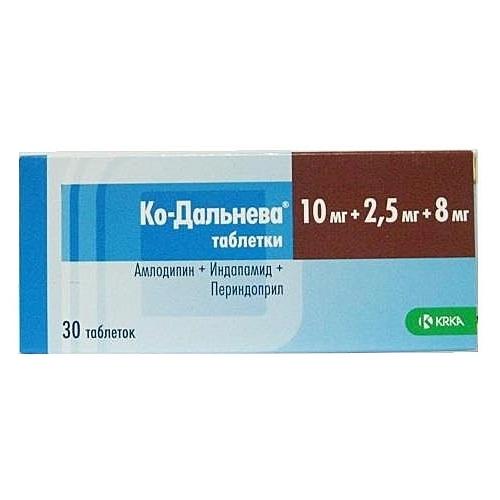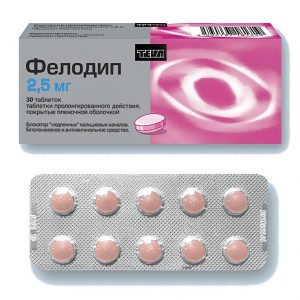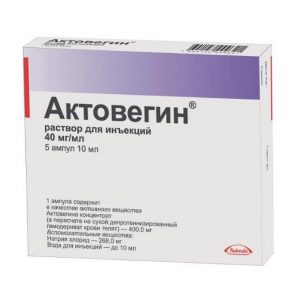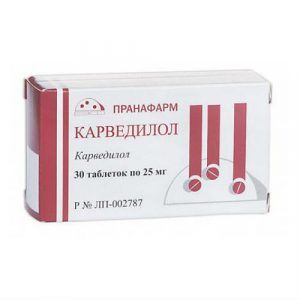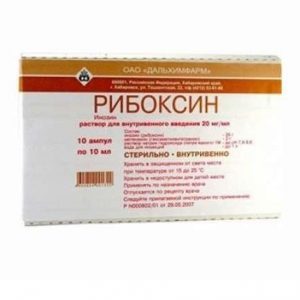Description
Pharmacological action of
Dalnev – a combined antihypertensive drug. Perindopril Perindopril is an ACE inhibitor. ACE or kinase 2 is an exopeptidase that converts angiotensin 1 into a vasoconstrictor substance, angiotensin 2, in addition, ACE destroys bradykinin, which has a vasodilating effect, to an inactive hectapeptide. Suppression of ACE activity leads to a decrease in angiotensin 2, an increase in plasma renin activity and a weakening of the secretion of aldosterone. Since ACE also destroys bradykinin, inhibition of ACE also leads to an increase in the activity of the kallikrein-kinin system. Perindopril acts through its active metabolite, perindoprilat. Other metabolites do not inhibit ACE. Perindopril has a therapeutic effect with any degree of arterial hypertension, reducing systolic and diastolic blood pressure in the supine and standing position. Reduces heart rate, resulting in increased peripheral blood flow without changes in heart rate (HR). Renal blood flow tends to increase, while GFR does not change. The antihypertensive effect reaches its maximum 4-6 hours after a single oral administration of perindopril and persists for 24 hours. The antihypertensive effect 24 hours after a single oral administration is about 87-100% of the maximum antihypertensive effect. A decrease in blood pressure develops rapidly. The therapeutic effect occurs less than 1 month after the start of therapy and is not accompanied by tachycardia. Discontinuation of therapy does not lead to the development of withdrawal syndrome. Perindopril has a vasodilating effect, helps to restore the elasticity of large arteries and the structure of the vascular wall of small arteries, and also reduces left ventricular hypertrophy. Amlodipine A derivative of dihydropyridine – a blocker of slow calcium channels, has an antianginal and hypotensive effect. It blocks calcium channels, reduces the transmembrane transition of calcium ions into the cell (more to the smooth muscle cells of blood vessels than to cardiomyocytes). The antianginal effect is due to the expansion of the coronary and peripheral arteries and arterioles: with angina pectoris it reduces the severity of myocardial ischemia by expanding peripheral arterioles, reduces OPSS, reduces myocardial afterload, reduces oxygen demand, expanding coronary arteries and arterioles in unchanged and ischemic myocardial zones, increases oxygen supply to the myocardium (especially with vasospastic angina pectoris) prevents spasm of the coronary arteries (including caused by smoking). In patients with stable angina, a single daily dose increases exercise tolerance, increases the time until an attack of angina pectoris and ischemic depression of the ST segment on the ECG, reduces the frequency of angina attacks and the consumption of nitroglycerin and other nitrates. It has a long dose-dependent hypotensive effect. The antihypertensive effect is due to a direct vasodilating effect on the smooth muscles of blood vessels. With arterial hypertension, a single dose provides a clinically significant reduction in blood pressure over 24 hours (in the patient s position, lying and standing). Orthostatic hypotension with the appointment of amlodipine is quite rare. Does not cause a decrease in the ejection fraction of the left ventricle. Reduces the degree of left ventricular myocardial hypertrophy. It does not affect myocardial contractility and conductivity, does not cause a reflex increase in heart rate, inhibits platelet aggregation, increases GFR, and has a weak natriuretic effect. With diabetic nephropathy does not increase the severity of microalbuminuria. It does not have any adverse effect on the metabolism and concentration of blood plasma lipids and can be used in the treatment of patients with bronchial asthma, diabetes mellitus and gout. A significant decrease in blood pressure is observed after 6-10 hours, the duration of the effect is 24 hours. Indapamide Indapamide is a sulfonamide derivative. By pharmacological properties, it is close to thiazide diuretics (diuretics). Indapamide inhibits the reabsorption of sodium ions in the cortical segment of the Henle loop, which leads to increased kidney excretion of sodium and chlorine ions, and to a lesser extent potassium and magnesium ions, thereby increasing diuresis and lowering blood pressure. In the monotherapy mode, the antihypertensive effect persists for 24 hours and is manifested when using the drug in doses that have a minimal diuretic effect. The antihypertensive effect of indapamide is associated with an improvement in the elastic properties of large arteries and a decrease in OPSS. On the background of taking indapamide, LVH decreases. Indapamide does not affect plasma lipids (triglycerides, total cholesterol, HDL, LDL), carbohydrate metabolism (including in patients with diabetes mellitus).
Indications
Arterial hypertension and / or coronary heart disease: stable angina pectoris in patients who require therapy with perindopril and amlodipine.
Contraindications
Hypersensitivity to amlodipine and other derivatives of dihydropyridine, indapamide and other derivatives of sulfonamide, perindopril and other ACE inhibitors, as well as to excipients that are part of the drug angioneurotic edema (associated with Quincke’s edema) / idiopathic angioneurotic edema bilateral renal artery stenosis, stenosis of a single kidney artery severe arterial hypotension (systolic blood pressure less than 90 mm Hg) shock, including cardiogenic shock, unstable angina (except for Prinzmetal angina) obstruction of the exit tract of the left ventricle (for example, clinically significant aortic stenosis) hemodynamically unstable heart failure after acute myocardial infarction, renal failure (CC less than 60 ml / min), severe liver failure, including including hepatic encephalopathy, refractory hypokalemia, simultaneous use with drugs that can cause polymorphic ventricular arrhythmias such as pyru et “simultaneous use with potassium-sparing diuretics, potassium and lithium preparations, in patients with high plasma potassium levels, simultaneous use of drugs, prolonging the QT interval, simultaneous use with aliskiren and aliskiren-containing drugs in patients with diabetes mellitus, pregnancy and the period of breastfeeding up to 18 years of age, given the lack of sufficient clinical experience, should not be used in patients on hemodialysis, as well as in patients with untreated heart failure in stages decompensation with caution: hepatic insufficiency of mild to moderate severity, systemic diseases of the connective tissue (including systemic lupus erythematosus, scleroderma), immunosuppressant therapy, allopurinol, procainamide (risk of neutropenia and agranulocytosis), inhibition of bone marrow hematopoiesis, decreased blood volume (diuretics, diet with restriction of sodium chloride, vomiting, diarrhea, hemodialysis), coronary heart disease, atherosclerosis, cerebrovascular disease, renovascular hypertension, diabetes mellitus, chronic heart failure (NYHA class IV functional class), hyperuricemia (especially in combination with gout and urate nephrolithiasis), simultaneous use of dantrolene, estramustine, surgical intervention / general anesthesia / general anesthesia / general anesthesia , blood pressure lability, hemodialysis using high-flow membranes (for example, AN69), before apheresis of low density lipoproteins (LDL) with schyu dextran sulfate, simultaneous desensitizing therapy allergens (e.g., hymenoptera venom) condition after kidney transplantation, aortic stenosis, mitral stenosis, hypertrophic obstructive cardiomyopathy (GOKMP) use in elderly patients and in patients of the Negroid race
Use during pregnancy and lactation
Contraindicated
Composition of
1 tablet contains: active ingredients: amlodipine besilate (amlodipine besilate) (13.870 mg), which is equivalent to amlodipine (10 mg), indapamide (2.5 mg) ), perindopril erbumin B substance-granules (40.824 mg) [active substance of the substance-granules: perindopril erbumin (8.0 mg) excipients of the granule substance: microcrystalline cellulose (31.6 mg), calcium chloride hexahydrate (2.4 mg)] excipients: microcrystalline cellulose (158.826 mg), pregelatinized starch (42.0 mg ), sodium carboxymethyl starch (16.8 mg), sodium bicarbonate (1.520 mg), colloidal silicon dioxide (0.860 mg), magnesium stearate (2.8 mg)
Dosage and administration
Inside, 1 tablet 1 time per day, preferably in the morning, before a meal, the dose of the drug is selected after previously titrated doses of the individual active components of the drug, the maximum daily dose of the drug is 10 mg amlodipine + 2.5 mg indapamide + 8 mg perindopril
Side effects
Amlodipine: from the hematopoietic system: leukopenia / neutropenia, thrombocytopenia from the immune system: allergic reactions from the metabolism: hyperglycemia, mental disorders: insomnia, mood lability (including anxiety), depression, from the nervous system: drowsiness (especially at the beginning of treatment), dizziness (especially at the beginning of treatment), headache, tremor, hypesthesia, paresthesia, taste changes, fainting, muscle hypertension, peripheral neuropathy by the organ of vision: visual disturbances (including diplopia) from the organ of hearing and balance: tinnitus from the cardiovascular system: palpitations, sensation of flushing of the face, a marked decrease in blood pressure (including orthostatic hypotension), myocardial infarction, possibly due to an excessive decrease in blood pressure in high-risk patients, rhythm disturbances heart (including bradycardia, ventricular tachycardia and atrial fibrillation), vasculitis (including hemorrhagic vasculitis) from the respiratory system: shortness of breath, rhinitis, cough from the digestive system: abdominal pain, nausea, vomiting, dyspepsia, changes defecation regimen (including diarrhea, constipation), dry mouth, gingival hyperplasia, pancreatitis, gastritis, hepatitis, jaundice, increased concentration of serum bilirubin, activity of liver enzymes (ALT and AST) on the part of the skin and subcutaneous tissues: skin itching rash, exfoliative dermatitis, Stevens-Johnson syndrome, photosensitivity, erythema multiforme exudative from the musculoskeletal system: arthralgia, myalgia, muscle spasms from the urinary system: painful urination, nocturia, frequent urination from the genitals and mammary gland: impotence, gynecomastia, allergy , angioedema of the face, limbs, lips, mucous membrane of the tongue, vocal folds and / or larynx other: peripheral edema, increase or decrease in body weight, increase constant prices fatigue, asthenia, chest pain, back pain, pain of various localization, general malaise with amlodipine observed only rare cases of extrapyramidal syndrome perindopril / indapamide: the part of the hemopoietic system: leukopenia / neutropenia, agranulocytosis or pancytopenia, thrombocytopenia, aplastic anemia, hemolytic anemia, in the treatment of ACE inhibitors in certain situations (after kidney transplantation, during dialysis), the development of anemia from the immune system was observed: hypersensitivity reactions in patients predisposed to bronchial obstruction and allergic reactions : mood lability (including anxiety), sleep disturbance from the nervous system: dizziness (especially at the beginning of treatment), headache, paresthesia sia, vertigo frequency is unknown – fainting on the part of the organ of vision: visual impairment (including diplopia) on the part of the organ of hearing and balance: noise (ringing) in the ears from the side of the cardiovascular system: marked decrease in blood pressure (incl. orthostatic hypotension), vasculitis (including hemorrhagic vasculitis), angina pectoris, myocardial infarction, possibly due to an excessive decrease in blood pressure in high-risk patients, cardiac arrhythmias (including bradycardia, ventricular tachycardia and atrial fibrillation), polymorphic ventricular tachycardia by type feasts (possibly fatal) from the digestive system: pain in abdomen, nausea, epigastric pain, vomiting, dyspepsia, changes in bowel movements (including diarrhea, constipation), dry mouth, impaired taste, decreased appetite, pancreatitis, angioedema ka, jaundice, hepatic encephalopathy in patients with liver failure of the skin and subcutaneous tissue: itching, rash, maculopapular rash, increased sweating, erythema multiforme, Stevens-Johnson syndrome, toxic epidermal necrolysis, photosensitivity from the musculoskeletal system: muscle cramps from the urinary system: renal failure, acute renal failure from the genitals and breast: impotence allergic reactions: urticaria, angioedema of the face, limbs, lips, mucous membrane of the tongue, vocal folds and / or larynx laboratory and instrumental data: hypercalcemia, frequency is unknown – an increase in the concentration of serum bilirubin, the activity of the liver enzymes ALT and AST, increased chenie QT interval on an electrocardiogram, elevated serum creatinine concentration in the urine and blood plasma passing after discontinuation, hypokalemia, hyponatremia and hypovolemia, leading to dehydration and orthostatic hypotension, increasing the concentration of uric acid and glucose in the blood plasma, hyperkalemia Other: asthenia, worsening of the course of the acute form of systemic lupus erythematosus
Overdose
Symptoms: the most likely symptoms of an overdose are a marked decrease in blood pressure with possible development of reflex tachycardia and excessive peripheral vasodilation (risk of severe and persistent arterial hypotension, including with the development of shock and fatal outcome) sometimes a pronounced decrease in blood pressure is accompanied by nausea, vomiting, convulsions, dizziness, drowsiness, confusion, oliguria, which can go into anuria (as a result of hypovolemia), water-electrolyte balance disturbances (hyponatremia, hypokalemia) can also treatment: emergency measures are aimed at removing the drug from the gastrointestinal tract: washing the stomach and / or taking activated charcoal with the subsequent restoration of the water-electrolyte balance with a marked decrease in blood pressure should be placed in a patient with an elevated position of the lower extremities, if necessary, correct hypovolemia (for example, intravenous infusion of 0.9% sodium chloride solution) perindoprilat, an active metabolite of perindopril, is removed by hemodialysis, amlodipine is closely associated with plasma proteins, therefore hemodialysis is ineffective indapamide is not removed by hemodialysis
Storage conditions
Store at a temperature not exceeding 25 ° C, in the original packaging, out of the reach of children.
Deystvuyuschee substances
amlodipine, indapamide, Perindopril
Terms and conditions otpuska IZ drugstore
prescription
Dosage form
tablets
